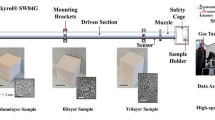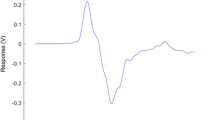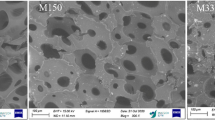Abstract
Polymeric foams are used for impact protection due to their ability to absorb large amounts of strain energy. In this work, the compressive response of an open cell polyurethane foam currently used as liner in the advanced combat helmet is examined across strain rates. A traditional load frame is used to investigate the quasi-static behavior, and two different modifications of a conventional Kolsky (split-Hopkinson) bar configuration are used to probe the dynamic response. A unique, independent method not relying on strain gage signals is presented that leverages high-speed full-field imaging to track the velocity on each side of the sample-bar interface and used to extract the dynamic stress-strain response; the results are compared against traditional strain gage measurements. X-ray tomography is used to examine the global morphological characteristics of the foam. The foam is found to be strongly rate dependent, where the characteristic properties vary logarithmically with strain rate. An analytical expression is presented to describe the rate dependency that collapses all stress-strain curves on a master curve. Full-field kinematic data from digital image correlation taken during loading is used to extract a nonlinear Poisson’s ratio as a function of strain, which is found to be strain rate insensitive. A tangent Poisson function is used to explore the foam’s auxetic behavior. These findings provide insight on physically-based constitutive modeling of foams, crucial to predictive brain injury simulations, as well as motivate the need to probe local heterogenous behavior across strain rates moving forward.
















Similar content being viewed by others
References
Ashby MF (1983) The mechanical properties of cellular solids. Metall Trans A 14(9):1755–1769
Gibson LJ, Ashby MF (1999) Cellular solids: structure and properties. Cambridge University Press, Cambridge
Lakes R (2009) Viscoelastic materials. Cambridge University Press, Cambridge
Siviour C, Jordan JL (2016) High strain rate mechanics of polymers: a review. J Dyn Behav Mater 2 (1):15–32
Moss WC, King MJ, Blackman EG (2014) Towards reducing impact-induced brain injury: lessons from a computational study of army and football helmet pads. Comput Methods Biomech Biomed Eng 17(11):1173–1184
Zhang L, Makwana R, Sharma S (2013) Brain response to primary blast wave using validated finite element models of human head and advanced combat helmet. Front Neurol 4:88
Li Y, Li X, Gao X-L (2015) Modeling of advanced combat helmet under ballistic impact, vol 82
Li X, Gao X-L, Kleiven S (2016) Behind helmet blunt trauma induced by ballistic impact: a computational model. Int J Impact Eng 91:56–67
Nagy A, Ko W, Lindholm US (1974) Mechanical behavior of foamed materials under dynamic compression. J Cell Plast 10(3):127–134
Sun Y, Li Q (2017) Dynamic compressive behaviour of cellular materials: a review of phenomenon, mechanism and modelling. International Journal of Impact Engineering
Avalle M, Belingardi G, Ibba A (2007) Mechanical models of cellular solids: parameters identification from experimental tests. Int J Impact Eng 34(1):3–27
Chen W, Song B (2010) Split Hopkinson (Kolsky) bar: design, testing and applications. Springer Science & Business Media
Gray G, Blumenthal W (2000) Split-hopkinson pressure bar testing of soft materials. ASM International, Materials Park, pp 488–496
Kolsky H (1949) An investigation of the mechanical properties of materials at very high rates of loading. Proc Phys Soc, Sect B 62(11):676
Ravichandran G, Subhash G (1994) Critical appraisal of limiting strain rates for compression testing of ceramics in a split hopkinson pressure bar. J Am Ceram Soc 77(1):263–267
Yang L, Shim V (2005) An analysis of stress uniformity in split hopkinson bar test specimens. Int J Impact Eng 31(2):129–150
Song B, Chen W (2004) Dynamic stress equilibration in split hopkinson pressure bar tests on soft materials. Exp Mech 44(3):300–312
Daniel IM, Cho J-M, Werner BT (2013) Characterization and modeling of stain-rate-dependent behavior of polymeric foams. Compos A: Appl Sci Manuf 45:70–78
Chen W, Zhang B, Forrestal M (1999) A split hopkinson bar technique for low-impedance materials. Exp Mech 39(2):81–85
Chen W, Lu F, Zhou B (2000) A quartz-crystal-embedded split hopkinson pressure bar for soft materials. Exp Mech 40(1):1–6
Song B, Chen W, Jiang X (2005) Split hopkinson pressure bar experiments on polymeric foams. Int J Veh Des 37(2-3):185–198
Chen W, Lu F, Winfree N (2002) High-strain-rate compressive behavior of a rigid polyurethane foam with various densities. Exp Mech 42(1):65–73
Zhao H, Gary G (1997) A new method for the separation of waves. application to the shpb technique for an unlimited duration of measurement. J Mech Phys Solids 45(7):1185–1202
Shim J, Mohr D (2009) Using split hopkinson pressure bars to perform large strain compression tests on polyurea at low, intermediate and high strain rates. Int J Impact Eng 36(9):1116–1127
Casem D, Fourney WL, Chang P (2003) A polymeric split hopkinson pressure bar instrumented with velocity gages. Exp Mech 43(4):420–427
Whisler D, Kim H (2015) Experimental and simulated high strain dynamic loading of polyurethane foam. Polym Test 41:219–230
Liu J, Saletti D, Pattofatto S, Zhao H (2014) Impact testing of polymeric foam using hopkinson bars and digital image analysis. Polym Test 36:101–109
Song B, Lu W-Y, Syn CJ, Chen W (2009) The effects of strain rate, density, and temperature on the mechanical properties of polymethylene diisocyanate (pmdi)-based rigid polyurethane foams during compression. J Mater Sci 44(2):351–357
Song B, Chen W, Dou S, Winfree NA, Kang JH (2005) Strain-rate effects on elastic and early cell-collapse responses of a polystyrene foam. Int J Impact Eng 31(5):509–521
Zhao H (1997) Testing of polymeric foams at high and medium strain rates. Polym Test 16(5):507–516
Lee YS, Park NH, Yoon HS (2010) Dynamic mechanical characteristics of expanded polypropylene foams. J Cell Plast 46(1):43–55
Saha M, Mahfuz H, Chakravarty U, Uddin M, Kabir ME, Jeelani S (2005) Effect of density, microstructure, and strain rate on compression behavior of polymeric foams. Mater Sci Eng: A 406(1-2):328–336
Bouix R, Viot P, Lataillade J-L (2009) Polypropylene foam behaviour under dynamic loadings: Strain rate, density and microstructure effects. Int J Impact Eng 36(2):329–342
Ouellet S, Cronin D, Worswick M (2006) Compressive response of polymeric foams under quasi-static, medium and high strain rate conditions. Polym Test 25(6):731–743
Cronin D, Ouellet S (2016) Low density polyethylene, expanded polystyrene and expanded polypropylene: Strain rate and size effects on mechanical properties. Polym Test 53:40–50
Bhagavathula KB, Azar A, Ouellet S, Satapathy S, Dennison CR, Hogan JD (2018) High rate compressive behaviour of a dilatant polymeric foam. Journal of Dynamic Behavior of Materials 4:573–585
Subhash G, Liu Q, Gao X-L (2006) Quasistatic and high strain rate uniaxial compressive response of polymeric structural foams. Int J Impact Eng 32(7):1113–1126
Barnes A, Ravi-Chandar K, Kyriakides S, Gaitanaros S (2014) Dynamic crushing of aluminum foams: Part i–experiments. Int J Solids Struct 51(9):1631–1645
Maire E, Withers P (2014) Quantitative x-ray tomography. Int Mater Rev 59(1):1–43
Dillard T, N’guyen F, Maire E, Salvo L, Forest* S., Bienvenu Y, Bartout J-D, Croset M, Dendievel R, Cloetens P (2005) 3D quantitative image analysis of open-cell nickel foams under tension and compression loading using x-ray microtomography. Phil Mag 85(19):2147–2175
Pierron F, McDonald S, Hollis D, Fu J, Withers P, Alderson A (2013) Comparison of the mechanical behaviour of standard and auxetic foams by x-ray computed tomography and digital volume correlation. Strain 49(6):467–482
Brun E, Vicente J, Topin F, Occelli R (2008) Imorph: A 3d morphological tool to fully analyse all kind of cellular materials. Cellular Metals for Structural and Functional Applications
Casem D, Weerasooriya T, Moy P (2005) Inertial effects of quartz force transducers embedded in a split hopkinson pressure bar. Exp Mech 45(4):368
Tagarielli V, Deshpande V, Fleck N (2008) The high strain rate response of pvc foams and end-grain balsa wood. Compos Part B: Eng 39(1):83–91
Arezoo S, Tagarielli V, Siviour C, Petrinic N (2013) Compressive deformation of rohacell foams: effects of strain rate and temperature. Int J Impact Eng 51:50–57
Gray III G, Idar D, Blumenthal W, Cady C, Peterson P (1998) High-and low-strain rate compression properties of several energetic material composites as a function of strain rate and temperature. Technical report, Los Alamos National Lab., NM
Song B, Chen W (2005) Split hopkinson pressure bar techniques for characterizing soft materials. Latin Amer J Solids Struct 2(2):113–152
Bacon C (1998) An experimental method for considering dispersion and attenuation in a viscoelastic hopkinson bar. Exp Mech 38(4):242–249
Sutton MA (2008) Digital image correlation for shape and deformation measurements. In: Springer handbook of experimental solid mechanics. Springer, pp 565–600
Greaves GN, Greer A, Lakes R, Rouxel T (2011) Poisson’s ratio and modern materials. Nat Mater 10(11):823
Smith C, Wootton R, Evans K (1999) Interpretation of experimental data for poisson’s ratio of highly nonlinear materials. Exp Mech 39(4):356–362
Pierron F (2010) Identification of poisson’s ratios of standard and auxetic low-density polymeric foams from full-field measurements. J Strain Anal Eng Des 45(4):233–253
Vicente J, Topin F, Daurelle J-V (2006) Open celled material structural properties measurement: from morphology to transport properties. Mater Trans 47(9):2195–2202
Vicente J, Daurelle J-V, Rigollet F (2006) Thermal conductivity of metallic foam: simulation on real x-ray tomographied porous medium and photothermal experiments. In: International heat transfer conference 13, begel house inc.
Avalle M, Belingardi G, Montanini R (2001) Characterization of polymeric structural foams under compressive impact loading by means of energy-absorption diagram. Int J Impact Eng 25(5):455–472
Ravindran S, Koohbor B, Malchow P, Kidane A (2018) Experimental characterization of compaction wave propagation in cellular polymers. Int J Solids Struct 139:270–282
Landauer A, Patel M, Henann D, Franck C (2018) A q-factor-based digital image correlation algorithm (qdic) for resolving finite deformations with degenerate speckle patterns. Exp Mech 58:815–830
Sanborn B, Song B (2019) Poisson’s ratio of a hyperelastic foam under quasi-static and dynamic loading. Int J Impact Eng 123:48–55
Mitschke H, Schury F, Mecke K, Wein F, Stingl M, Schröder-Turk GE (2016) Geometry: The leading parameter for the poisson’s ratio of bending-dominated cellular solids. Int J Solids Struct 100:1–10
Pierron F, Zhu H, Siviour C (2014) Beyond hopkinson’s bar, vol 372
Koohbor B, Kidane A, Lu W-Y, Sutton MA (2016) Investigation of the dynamic stress–strain response of compressible polymeric foam using a non-parametric analysis. Int J Impact Eng 91:170–182
Acknowledgements
This research is performed under grant N00014-18-1-2494 from the Office of Naval Research. The authors would like to thank Dr. Antonios Zavaliangos and his research group of the Department of Material Science and Engineering at Drexel University for allowing us to use the x-ray microtomograph. Special thanks for the fruitful discussions with the research teams of Dr. Christian Franck of the University of Wisconsin-Madison, Dr. Haneesh Kesari, Dr. Diane Hoffmann-Kim, and Dr. David Henann of Brown University, Mr. Ron Szalkowski of TeamWendy, Dr. Chad Hovey of Sandia National Laboratories. Additional thanks to Dr. Bo Song of Sandia National Laboratories for his discussion on properly utilizing the Kolsky method and Dr. Fabrice Pierron for his discussion on Poisson’s ratio quantification. Lastly, thank you to the Dynamic Multifunctional Materials Laboratory members at Drexel University for the direct and indirect support on this project.
Author information
Authors and Affiliations
Corresponding author
Additional information
Publisher’s Note
Springer Nature remains neutral with regard to jurisdictional claims in published maps and institutional affiliations.
The authors gratefully acknowledge the support from the Office of Naval Research (Dr. Timothy Bentley) under grant N00014-18- 1-2494.
Rights and permissions
About this article
Cite this article
Koumlis, S., Lamberson, L. Strain Rate Dependent Compressive Response of Open Cell Polyurethane Foam. Exp Mech 59, 1087–1103 (2019). https://doi.org/10.1007/s11340-019-00521-3
Received:
Accepted:
Published:
Issue Date:
DOI: https://doi.org/10.1007/s11340-019-00521-3




